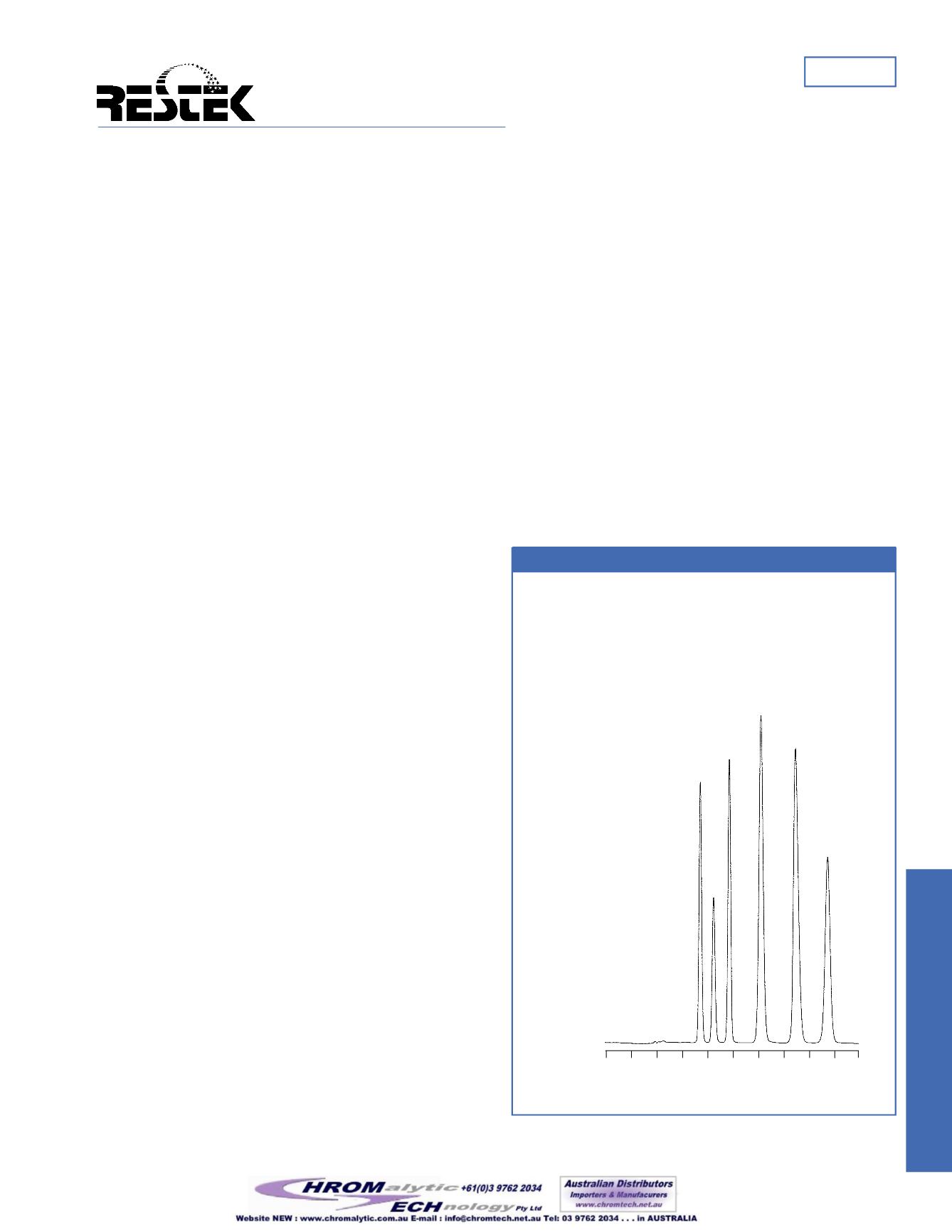
1
2
3
4
5
6
0
1
2
3
4
5 min.
HPLC
Applications
note
Restek Corporation • (800) 356-1688 • (814) 353-1300 •
#59398
HPLC
Analysis of PreservativesUsingHPLC
Background
Preservatives are chemical compounds that are used in a wide
range of applications to maintain overall product quality.
1
For
example, preservatives are used in foods, beverages, pharmaceuti-
cals, andpersonal care products. Some preservatives act as antimi-
crobial agents, some act as antioxidants, and some can perform
both functions.To some extent, the abilityof the chemical to act as
a preservative depends on the environment, so factors such as the
type of product,water content, pH, and storage conditions all need
to be consideredwhen selecting a preservative.
Of the chemical compounds commonly used as preservatives,
many of them can be effectively analyzed by high performance
liquid chromatography (HPLC).
2
Chromatographic techniques
such as HPLC separate preservative compounds from the rest of
the sample matrix, providing more accurate results compared to
traditional techniques such as spectrophotometry. Because preser-
vatives include a number of different compound types, there are a
variety of HPLC stationary phases, mobile phases, and detectors
that can be used.
Microbial Growth Inhibitors
Microbes such asmolds, yeasts, and bacteria need to have certain
conditions (e.g., water, pH, temperature) in order to flourish.
Chemical preservatives canbeused tokill or prevent thegrowthof
these microbes by either changing their environment or reacting
directly with the microbes.
3
Selecting the best preservative for a
givenproduct canbe an important part of product development. In
addition, other chemical compounds known as synergists can
increase the effectiveness of some preservatives. Examples of syn-
ergists include: citric acid, isopropyl citrate, phosphoric acid,
ascorbic acid, ascorbyl palmitate, tartaric acid, and lecithin.
Antimicrobial compounds include organic acids, benzoate and
sorbate salts, sulfur dioxide and sulfites, nitrites, propionates, and
parabens. Some antimicrobials act on yeasts, molds, and bacteria,
while some specifically target certain classes ofmicrobes. Sulfites
can inhibit bacteria, but are not effective against yeasts. For this
reason, they often are used as preservatives inwines. Nitrites can
inhibit botulism (bacterial spores) inmeats.Sorbatesandbenzoates
are specific inhibitors of bacteria, while propionates act onmolds
and rope bacteria, but not on yeasts. Therefore propionates can be
used inyeastedbreadproducts. Theparabens haveboth antimicro-
bial activity and antioxidant activity.
Organic acids, such as acetic acid and citric acid, can be used to
control the pH of a product. For example, in food products these
acidulants can lower the pH out of the optimum pH range for bac-
teria, yeast, and/or molds. Organic acids such as malic acid and
citricacidcanbe foundnaturally in fruits; oxalicacidcanbe found
in spinach and rhubarb; and tartaric acid can be found in grapes.
Using HPLC, concentrations of these preservatives can be moni-
tored. However, analyzing polar organic acids can be difficult on
conventional reversed phase columns, even when using highly
aqueousmobile phases. TheUltraAqueous C18 column provides
enhanced retention and selectivity for challenging applications
such as this. The novel bonding chemistry used for this phase
allows thealkyl groups to remainextended, even inhighlyaqueous
mobile phase, preventing the chain folding that occurs with con-
ventional C18phases. Therefore, stable and reproducible retention
is possible even with 100% aqueous mobile phases. Notice the
excellent retention for a series of organic acids using the Ultra
AqueousC18 column andUV detection (Figure 1).
Benzoate and sorbate salts also can be used as preservatives in a
range of consumer products. These salts interact with the bacteria
itself, limiting the viability of the microorganism. These com-
pounds canbe analyzed in their acid form (i.e. as benzoic acid and
Analysis of a series of organic acids typically found in items
such as foods, beverages, and personal care products, using an
UltraAqueousC18 column shows excellent retention of
organic acids, evenwith a highly aqueousmobile phase.
PeakList:
Conc. (µg/mL):
1. malonic acid 500
2. lactic acid
500
3. acetic acid 1000
4. citric acid
1000
5. succinic acid 2000
6. fumaric acid 10
Sample:
Solvent:
HPLC-gradewater
Inj.:
10µL
Column:
UltraAqueousC18
Catalog #:
9178565
Dimensions: 150 x 4.6mm
Particle size: 5µm
Pore size:
100Å
Conditions:
Mobile phase: 50mM potassium
phosphate, pH 2.5:
acetonitrile (99:1)
Flow:
1.5mL/min.
Temp.:
25°C
Det.:
UV@210nm
LC_0140
Figure 1


